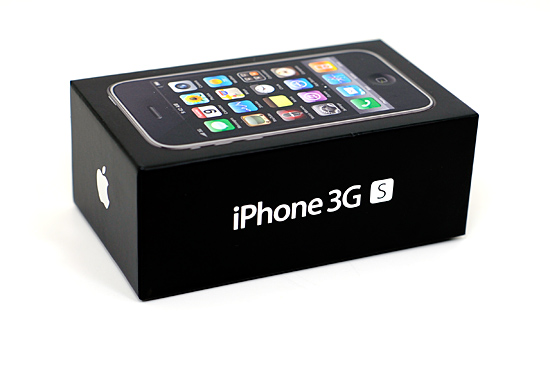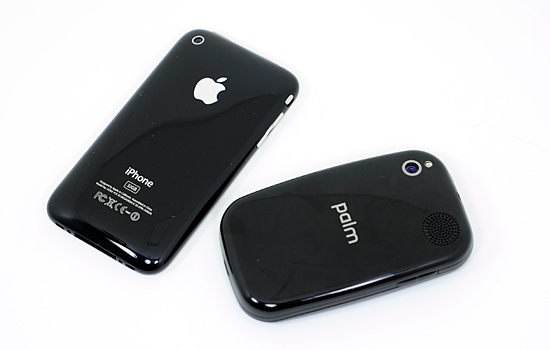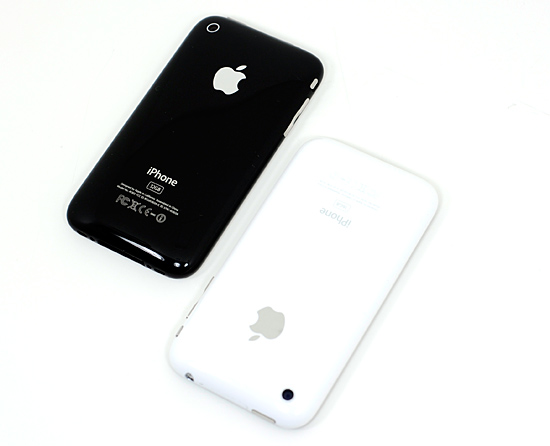iPhone 3GS Performance: A Significant Performance Bump
by Anand Lal Shimpi on June 19, 2009 12:00 AM EST- Posted in
- Smartphones
- Mobile
You may have noticed today's review of the Palm Pre. While I strongly suggest reading it if you're at all interested, I do have some new data for your consumption. After the announcement of the iPhone 3GS I posted an article discussing the hardware specs of the 3GS. I outlined the single chip CPU/GPU SoC as follows:
| iPhone 3G (ARM11) | iPhone 3GS (ARM Cortex A8) | |
| Manufacturing Process | 90nm | 65nm |
| Architecture | In-Order | In-Order |
| Issue Width | 1-issue | 2-issue |
| Pipeline Depth | 8-stage | 13-stage |
| Clock Speed | 412MHz | 600MHz |
| L1 Cache Size | 16KB I-Cache + 16KB D-Cache | 32KB I-Cache + 32KB D-Cache |
| L2 Cache Size | N/A | 256KB |
The iPhone 3GS uses an ARM Cortex A8 processor running at 600MHz, much like the Palm Pre. Many weren't confident that the 3GS used the new ARM A8 core instead of a higher clocked ARM11, so after waiting in line to grab a 3GS this morning I decided to run a few tests (the iPhone 3G tests were using OS 3.0 and the Pre tests used OS 1.0.2).
Update: Thanks to the many readers who have pointed out my incorrect wording of the 3GS' performance improvements. The tables in the article have been updated to reflect the correct percentages. I appreciate the corrections :)

| WiFi | Apple iPhone 3G | Apple iPhone 3GS | Palm Pre | T-Mobile G1 |
| anandtech.com | 16.3 s | 7.8 s | 8.2 s | 17.2 s |
| arstechnica.com | 17.7 s | 6.3 s | 7.8 s | 17.8 s |
| hothardware.com | 35.2 s | 14.7 s | 11.2 s | 24.4 s |
| pcper.com | 33.3 s | 15.0 s | 18.0 s | 34.0 s |
| digg.com | 34.3 s | 15.0 s | 22.1 s | 40.0 s |
| techreport.com | 24.1 s | 9.6 s | 9.0 s | 20.5 s |
| tomshardware.com | 21.4 s | 16.4 s | 13.8 s | 26.0 s |
| slashdot.org | 26.0 s | 10.0 s | 20.9 s | 46.0 s |
| facebook.com | 31.7 s | 13.5 s | 19.6 s | 37.7 s |
| iPhone 3GS Advantage over Palm Pre | 21% | |||
| iPhone 3GS Advantage over iPhone 3G | 122% |
The new 3GS renders web pages 128% faster, on average, than the old iPhone 3G. The 45% clock speed boost alone isn't enough to generate such a large performance increase, this is a new microarchitecture. Also, note that the 3GS' performance mimics that of the Palm Pre - another Cortex A8 based phone.

Not too surprising given the just-released nature of the Pre's webOS, the 3GS is actually able to render webpages slightly faster than the Pre in some cases. The overall performance advantage ends up being 22.6% in favor of the 3GS over the Pre.
Application launch time has also improved (I've updated the results with data from the iPhone OS 3.0):
| Application Launch Time in Seconds | Web Browser | Dialer | Google Maps | Camera | |
| Apple iPhone 3GS | 0.7 s | 0.7 s | 2.7 s | 2.8 s | 0.8 s |
| Apple iPhone 3G | 0.8 s | 1.2 s | 3.3 s | 3.9 s | 1.2 s |
| Palm Pre | 3.0 s | 1.5 s | 8.6 s | 4.4 s | 3.3 s |
| T-Mobile G1 | 5.4 s | 2.0 s | 4.4 s | 4.9 s | 2.0 s |
| iPhone 3GS vs. 3G Performance Advantage | 14% | 71.5% | 22.2% | 39.4% | 50% |
While the old iPhone 3G was no slouch, the 3GS is anywhere from 14 - 72% faster in basic application load times. It's the magic of a brand new CPU architecture.

I'll be working on the 3GS all weekend and hope to provide a more thorough look at CPU, GPU and battery life performance with the new hardware. Enjoy.










75 Comments
View All Comments
MultiCarrierUser - Saturday, June 20, 2009 - link
[EDIT: No shouting in CAPS, thank you!]Alright, you seriously compared the devices Wi-Fi speed, that is too funny. Wi-Fi do not cover ground like both sprint and AT&T both gloat about. I say for all you iPhone lovers, test iPhone 3GS (16GB/32GB) vs. palm pre' using their own carriers data speeds, see who wins? I say this because you'll more than likely 85% of the time use your own carriers data network instead of Wi-Fi unless you're on college campus, airport, gov't building, something major, how about outside your home, walking in the park, at the beach, bus station, outside your child's school while waiting to pick them up, how about outside the movie theatre's trying to check that movie time again....using Wi-Fi is not the way to go, but if you really want to, head up to Baltimore and use sprint's, that right sprint's 4g called WiMAX....post your true results, everyone look for someone with an iPhone 3gs, and vice versa all iPhone 3gs look for someone with a palm pre', toss out the Wi-Fi and go head to head using your carriers data speeds head to head, I dare you at&t!
The0ne - Sunday, June 21, 2009 - link
You need to learn how to type or not comment at all.MultiCarrierUser - Monday, June 22, 2009 - link
Too funny, you're commenting on my typing? Come on now, let's get real. I did not know that my typing skills were being analyzed. Let me now apologize to all perfect commentators on this and all other sites, lol....But I really didn't think my all caps would be taken as shouting, perception I love and hate it.araczynski - Saturday, June 20, 2009 - link
still crappy resolution? i'll wait for their 10th revision of the thing before biting.Charbax - Saturday, June 20, 2009 - link
Archos released the first ARM Cortex A8 based product in the Archos 5, Archos 7 and the Archos 5G about 10 months ago. Still I am sure Archos has a faster web browwser, even considering that the Archos HSDPA or WiFi browser has 3x more pixels at 800x480 on a still very pocketable 2x larger screen at 4.8" in diameter. Archos is releasing the next generation in September, running Android, even thinner, with up to 500GB, and even better optimized.anandtech02148 - Saturday, June 20, 2009 - link
I have tmobile data plan and att data plan. I don't why people are so upset with aTT, but their data Plan is cheap and peforms it's worth and i mean data plan only not the stiff contract from iphone. Tmobile is just horrid and Verizon is just pure evil someone should knock them off their high horse. Sprint is promising base on this review.ChodaBoyUSA - Saturday, June 20, 2009 - link
For the Pre, did you use webOS 1.0.3?jonyah - Friday, June 19, 2009 - link
The Pre's processor is rated at 600mhz, but it's locked to 500mhz. After obtaining root access you can up it to 600 as well as turn on scaling to save battery life. This battle is far from over.PhysicsPhil - Friday, June 19, 2009 - link
Take this simple example as proof:Say you have two racecars.
Car_A and Car_B are moving at constant speeds.
Car_A is traveling at 100 mph
Car_B is traveling at 154 mph
Car_B is moving 54% faster
(i.e. 54% more distance is covered by Car_B than Car_A over the same time interval).
For both cars to travel 100 miles, there times would be as such:
Time_A = 100 miles / 100 mph = 1 hr;
Time_B = 100 miles / 154 = 0.649 hr;
Therefore Car_B takes 35.1% less time than Car_A to cover the same distance because it is 54% faster.
The "54%" in the article is the REDUCTION IN TIME... BTW if rounded properly it's actually 55%.
(108.3 sec / 240 sec) = 0.45125
so according to this the same result is achieved on the iPhone 3Gs in about 45% of the time, meaning:
100% time / 45% time = 220% of the original 100%
which is 120% faster...
PrinceGaz - Friday, June 19, 2009 - link
If you have an iTouch 2G to hand, could you possibly compare website loading speeds on it with the iPhone 3G (using WiFi of course). The reason is because the iTouch 2G clocks its ARM11 at 533MHz instead of 412MHz - a 29% clockspeed increase. It would be interesting to see how much difference that 29% translates to in real-world performance.